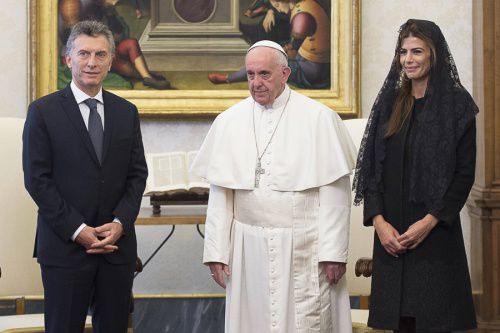With an eye toward divorced-and-remarried Catholics, Pope Francis has recently changed protocol for heads of state who are visiting the Pope at the Vatican.
Catholic heads of state who are in an irregular marital situation may now take part in an official visit to the Pope as a couple, accompanied by their irregular spouse.
The Pope made the change in February. By chance, the first to benefit from the new protocol was Argentina’s President Mauricio Macr√¨. He made an official visit to Pope Francis Feb. 27, accompanied by his third wife, Juliana Awada. Before the change in protocol, the Catholic head of state in an irregular marital situation could not be accompanied by his or her irregular spouse during the visit. The new spouse waited in another room and was not included in the official picture. The Pope later greeted the irregular spouse separately. This protocol was observed only for Catholic heads of state. If a head of state was not a Catholic, there were no exceptions.
“The deep reason why a Catholic head of state could not be accompanied by an irregular spouse is because the Pope is not a mere head of state: he is a head of state because he is the Pope, and as a Pope he also leads the Vatican City State,” a source who is an expert in Vatican protocol told CNA March 8. In this previous understanding, the source maintained, the Pope “could not silently approve an irregular marital situation by acknowledging it, though indirectly, in an official visit.” The new protocol does not fully take this issue into consideration. Rather, it is aimed to emphasize the need to “integrate” divorced-and-remarried persons in the life of the Church. The Prefecture of the Pontifical Household is the Vatican body in charge of organizing visits of heads of state for the Pope. According to CNA’s source, the prefecture was not consulted on the decision to change the protocol. Following the change of protocol, Catholic heads of state will be accompanied by their spouse even if they are in an irregular marital situation. The irregular partner will be able to greet the Pope and will be included in the official photo of the event and in the exchange of gifts. Sources maintain the protocol change was conceived within the Vatican Secretariat of State, though the rumor could not be confirmed. The protocol change does not affect in any way the doctrine of the Church on marriage.
During the Feb. 18 inflight press conference coming back from Mexico, the Pope spoke about the need to integrate Catholics who have divorced and contracted a civil marriage. But the Pope also clearly stated that “integrating in the Church doesn’t mean receiving Communion.”
“I know married Catholics in a second union who go to church, who go to church once or twice a year and say ‘I want Communion,’ as if joining in Communion were an award. It’s a work towards integration. All doors are open, but we cannot say, ‘from here on they can have Communion.’ This would be an injury also to marriage, to the couple, because it wouldn’t allow them to proceed on this path of integration.”
Cardinal Gerhard Müller, prefect of the Congregation for the Doctrine of the Faith, recently spoke about the Church and couples in irregular unions.
“A second marriage or a second spouse, as long as the rightful spouse is still alive, is not possible according to the Catholic interpretation of the words of Jesus,” he said in a March 1 interview with a German newspaper.
“The Pope and all of us however want to carefully avoid people ‘drifting away’ from the Church as community of salvation.”

